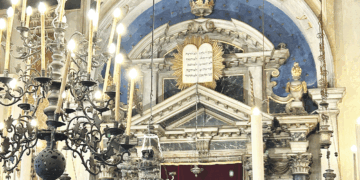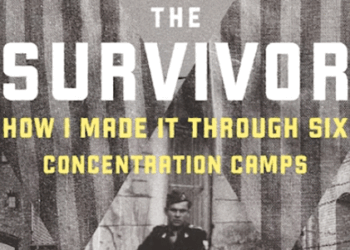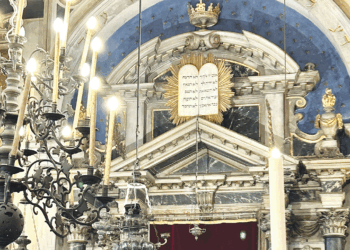Reviewed by MICHAEL FOX
The most surprising aspect, frankly, of the engaging two-hour PBS documentary, Jerusalem: Center of the World, is how casually yet completely it sidesteps controversy.
Even a viewer with only a superficial awareness of the Middle East has to wonder going in how American public television would confront the combustible triumvirate of religion, power (or war, if you prefer) and land.
One can only conclude from producer-director Andrew Goldberg’s decision to condense the last 150 years into the final five minutes of screen time that avoiding political hot buttons was an explicit goal. All we can say is, mission accomplished.
It’s a bit unfair, actually, to mock the program’s evasion of the messy present, for it’s clear from the outset, and from the travelogue format, that there is no urgent public-affairs agenda propelling host Ray Suarez (of The Newshour with Jim Lehrer) and company forward. This is simply a lucid, generous-to-all rendering of history for its own sake, filtered through three religions yet wrested free of the emotion and dogma that colors most views of the Holy City.
Jerusalem: Center of the World airs 8 p.m. Wednesday, April 1 on TPT Channel 2. It will repeat 2 a.m. Thursday, April 2 on TPT Channel 2 (check local listings).
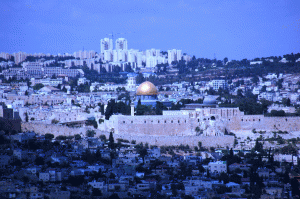
Conceived and presented as a chronological view that draws on extant biblical studies, archaeological analysis and historical research, the well-paced program evinces a catholic point of view. It shifts from Judaism to Christianity to Islam as Jerusalem successively shifted to the forefront of each religion over four millennia.
It has a surprisingly relaxed tone, exemplified by Suarez’s white chinos and interviews conducted outdoors in the open air rather than in the experts’ stuffy offices or libraries. The documentary also embraces occasional moments of lightness with cameos by Indiana Jones, Mark Twain and (perhaps less amusingly) the Queen of Sheba.
Jerusalem: Center of the World begins with Abraham, the first monotheist (and first megachurch preacher, as one historian describes him). The already sacred spot where Abraham went to sacrifice Isaac, Mount Moriah, soon became the city of Jerusalem.
The next key figure (after Moses) was the warrior king David who, seeking to unite the 12 tribes, took Jerusalem, made it the capital and drew up plans to build an edifice to house the Ark of the Covenant. It was left to Solomon to carry out the job, and his temple stood for more than 400 years until the Babylonians conquered Judah, and Nebuchadnezzar destroyed it along with Jerusalem.
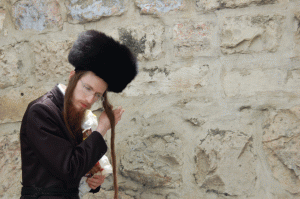
It was Herod who rebuilt the temple, on a vast mount. When Jesus, an iconoclastic Jew, came to Jerusalem, he was hailed as the Messiah by his followers (although the belief that he was the son of God was not a Jewish concept).
After the destruction of the second temple in 70 A.D. by the Romans, and the end of the revolt three years later at Masada, Jews were expelled from Jerusalem. This tragedy inspired the Amidah, the three-times-a-day prayer asking God to rebuild Jerusalem and restore King David’s throne.
No Jews lived in Jerusalem for the next 500 hundred years, until the Muslims gained control of the city and allowed 70 Jewish families to move in. The Crusades brought the Christian army to Jerusalem for a bloody battle that ended with the massacre of the defeated Muslims along with the comparatively small group of Jewish inhabitants.
Over the ensuing centuries, Jews trickled back into Jerusalem, although it can’t be said that the chosen people prospered. They were supported by Jews in the Diaspora, who considered them “the guardians of the synagogue, the poorest of the poor, the penniless princes.”
Andrew Goldberg (Anti-Semitism in the 21st Century) moves crisply through the shifting sand dunes, avoiding the dry pedantry of arcane history. But no one will mistake Jerusalem: Center of the World for adventurous filmmaking or, for that matter, a road map to resolving current tensions.
The closest the documentary comes to editorializing of any kind is a lingering shot, in the waning moments, of the separation barrier in the sun-baked landscape. After two hours and 4,000 years, we’re left to ponder if it will last as long as the walls Saladin erected around the Old City, or the temple built by Herod.
(American Jewish World, 3.27.09)

